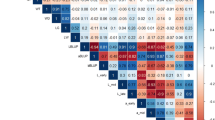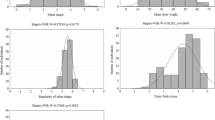Abstract
Quantitative trait locus (QTL) analysis for tuber dormancy was performed in a diploid potato population (TRP133) consisting of 110 individuals. The female parent was a hybrid between haploid S. tuberosum (2x) and S. chacoense, while the male parent was a S. phureja clone. The population was characterized for ten isozyme loci, 44 restriction fragment length polymorphisms (RFLPs) and 63 random amplified polymorphic DNAs (RAPDs). Eighty-seven of these loci segregating from the female parent were utilized to develop a linkage map that comprised 10 of the 12 chromosomes in the genome. Dormancy, as measured by days-to-sprouting after harvest, ranged from 10 to 90 days, with a mean of 19 days. QTLs were mapped by conducting one-way analyses of variance for each marker locus by dormancy combination. Twenty-two markers had a significant association with dormancy, identifying six putative QTLs localized on each of chromosomes 2, 3, 4, 5, 7 and 8. The QTL with the strongest effect on dormancy was detected on chromosome 7. A multilocus model was developed using the locus with highest R2 value in each QTL. This model explained 57.5% of the phenotypic variation for dormancy. Seven percent of possible epistatic interactions among significant markers were significant when tested through two-way analyses of variance. When these were included in the main-effects model, it explained 72.1% of the phenotypic variation for dormancy. QTL analysis in potato, the methodology to transfer traits and interactions into the 4x level, and QTLs of value for marker-assisted selection, are discussed.
Similar content being viewed by others
References
Bogucki S, Nelson DC (1980) Length of dormancy and sprouting characteristics of ten potato cultivars. Am Potato J 57:151–157
Bonierbale M, Plaisted R, Tanksley SD (1988) RFLP maps based on a common set of clones reveal modes of chromosomal evolution in potato and tomato. Genetics 120:1095–1103
Burton WG (1963) Concepts and mechanisms of dormancy. In: Ivins JD, Milthorp FL (eds) Growth of the potato. Butterworth, London, pp 189–284
Burton WG (1966) The potato. A survey of its history and factors influencing its yield, nutritive value, quality and storage. Veenman, Wageningen
Chase SA (1968) Analytical breeding in S. tuberosum L.: a scheme utilizing parthenotes and other diploid stocks. Can J Genet Cytol 5:359–363
Coleman WK (1987) Dormancy release in potato tubers: a review. Am Potato J 64:57–68
Diers BW, Cianzio SR, Shoemaker RC (1992) Possible identification of quantitative trait loci affecting iron deficiency in soybean. J Plant Nutrition 15:2127–2136
Edwards MD, Stuber CW, Wendel JF (1987) Molecular-marker-facilitated investigations of quantitative-trait loci in maize. I. Numbers, genomic distribution and types of gene action. Genetics 116:113–125
Flewelling HS (1987) Use of haploid tuberosum-wild Solanum species F1 hybrids to study the relationship between the cultivated and wild potatoes, and to analyze the genetic control of tuber dormancy. MS thesis. University of Wisconsin-Madison
Freyre R, Douches DS (1994) Isoenzymatic identification of quantitative traits in crosses between heterozygous parents: mapping tuber traits in diploid potato (Solarium spp). Theor Appl Genet 87:764–772
Gebhardt C, Ritter E, Barone A, Debener T, Walkemeier B, Schachtschabel U, Kaufmann H, Thompson RD, Bonierbale MW, Ganal MW, Tanksley SD, Salamini F (1991) RFLP maps of potato and their alignment with the homoeologous tomato genome. Theor Appl Genet 83:49–57
Hackett CA, Ellis RP, Forster BP, McNicol JW, Macaulay M (1992) Statistical analysis of a linkage experiment in barley involving quantitative trait loci for height and ear-emergence time and two genetic markers on chromosome 4. Theor Appl Genet 85:120–126
Hayes PM, Blake T, Chen THH, Chen F, Pan A, Liu B (1992) Quantitative trait loci on barley (Hordeum vulgare L.) chromosome 7 associated with components of winter hardiness. Genome 36:66–71
Hemberg T (1985) Potato rest. In: Li PH (ed) Potato physiology. Academic Press Inc., pp 353–388
Hermundstad SA (1986) Haploid-wild species hybrids in potato breeding, genetics, and germplasm enhancement. PhD thesis. University of Wisconsin-Madison
Hermundstad SA, Peloquin SJ (1985) Germplasm enhancement with potato haploids. J Hered 76:463–467
Heun M (1992) Mapping quantitative powdery mildew resistance of barley using a restriction-fragment-length-polymorphism map. Genome 35:1019–1025
Iwanaga M (1983) Ploidy level manipulation approach: development of diploid populations with specific resistance and FDR 2n pollen production. In: Present and future strategies for potato breeding and improvement. Rep 26th Planning Conf, CIP, Lima, Peru, pp 57–70
Jeoung LC, Iritani WM, Martin MW (1983) Comparison of methods for measuring dormancy of potatoes. Heredity 19:489–504
Keim P, Diers BW, Shoemaker RC (1990) Genetic analysis of soybean hard seedness with molecular markers. Theor Appl Genet 79:465–469
Lander ES, Green P, Abrahamson J, Barlow A, Daly MJ, Lincoln SE, Newburg L (1987) Mapmaker: an interactive computer package for constructing primary genetic linkage maps of experimental and natural populations. Genomics 1:174–181
Lander E, Botstein D (1989) Mapping Mendelian factors underlying quantitative traits using RFLP linkage maps. Genetics 121:185–199
Miura H, Parker BB, Snape JW (1992) The location of major genes and associated quantitative trait loci on chromosome arm 5BL of wheat. Theor Appl Genet 85:197–204
Nienhuis J, Helentjaris T, Slocum M, Ruggero B, Schaefer A (1987) Restriction-fragment-length-polymorphism analysis of loci associated with insect resistance in tomato. Crop Sci 27:797–803
Paterson AH, Lander ES, Hewitt JD, Peterson S, Lincoln ES, Tanksley SD (1988) Resolution of quantitative traits into Mendelian factors, using a complete linkage map of restriction fragment length polymorphisms. Nature 335:721–726
Paterson AH, DeVerna JW, Lanini B, Tanksley SD (1990) Fine mapping of quantitative trait loci using selected overlapping recombinant chromosomes, in an interspecies cross of tomato. Genetics 124:735–742
Paterson AH, Damon S, Hewitt JD, Zamir D, Rabinowitch HD, Lincoln ES, Lander ES, Tanksley SD (1991) Mendelian factors underlying quantitative traits in tomato: comparison across species, generations and environments. Genetics 127:181–197
Peloquin SJ, Yerk GL, Werner JE, Darmo E (1989) Potato breeding with haploids and 2n gametes. Genome 31:1000–1004
Peloquin SJ, Ortiz R (1991) Techniques for introgressing unadapted germplasm to breeding populations. In: Stalker HT, Murphy JP (eds) Plant breeding in the 1990s. Proc Symp Plant Breed in the 1990s. North Carolina State University, Raleigh, N.C., pp 485–505
Quiros CF, Ceada A, Georgescu A, Hu J (1993) Use of RAPD markers in potato genetics — segregations in diploid and tetraploid families. Am Potato J 70:35–42
Ritter E, Gebhardt C, Salamini F (1990) Estimation of recombination frequencies and construction of RFLP linkage maps in plants from crosses between heterozygous parents. Genetics 125:645–654
Ruttencutter G, Haynes F, Moll R (1979) Estimation of narrow-sense heritability for specific gravity in diploid potatoes (S. tuberosum subsp. phureja and stenotomum) Am Potato J 56:447–453
Saghai-Maroof MA, Soliman KM, Jorgesen RA, Allard RW (1984) Ribosomal DNA spacer length polymorphisms in barley: Mendelian inheritance, chromosomal location, and population dynamics. Proc Natl Acad Sci USA 81:8014–8018
Simmonds NW (1964) The genetics of seed and tuber dormancy in the cultivated potatoes. Heredity 19:489–504
Sisco PH, Senior ML, Rhyne DC (1990) RFLP techniques. Laboratory Manual. USDA-ARS, North Carolina State University, Raleigh, NC
Soller M, Brody T (1976) On the power of experimental designs for the linkage between marker loci and quantitative loci in crosses between inbred lines. Theor Appl Genet 47:35–39
Stuber CW, Edwards MD, Wendel JF (1987) Molecular-marker-facilitated investigations of quantitative trait loci in maize. II. Factors influencing yield and its component traits. Crop Sci 22:737–740
Suiter KS, Wendel JF, Case JS (1983) LINKAGE-1: a Pascal computer program for the detection and analysis of genetic linkage. J Hered 74:203–204
Tanksley SD, Hewitt J (1988) Use of molecular markers in breeding for soluble-solids content in tomato — a re-examination. Theor Appl Genet 75:811–823
Tanksley SD, Medina-Filho H, Rick CM (1982) Use of naturally-ocurring enzyme variation to detect and map genes controlling quantitative traits in an interspecific backcross of tomato. Heredity 49:11–25
Tanksley SD, Ganal MW, Prince JP, de Vicente MC, Bonierbale MW, Broun P, Fulton TM, Giovannoni JJ, Grandillo S, Martin GB, Messeguer R, Hiller JC, Miller L, Paterson AH, Pineda O, Roder MS, Wing RA, Wu W, Young ND (1992) High-density molecular linkage maps of the tomato and potato genomes. Genetics 132:1141–1160
Thompson P, Haynes F, Moll R (1980) Estimation of genetic-variance components and heritability for tuber dormancy in diploid potatoes. Am Potato J 57:39–46
Vaughn SF, Spencer GF (1991) Volatile monoterpenes inhibit potato tuber sprouting. Am Potato J 68:821–831
Weller JI, Soller M, Brody T (1988) Linkage analysis of quantitative traits in an interspecific cross of tomato (Lycopersicon esculentum x Lycopersicon pimpinellifolium) by means of genetic markers. Genetics 118:329–339
Williams JCK, Kubelik AR, Livak KJ, Rafalski JA, Tingey SV (1990) DNA polymorphisms amplified by arbitrary primers are useful as genetic markers. Nucleic Acids Res 18:6531–65352
Author information
Authors and Affiliations
Additional information
Communicated by A. R. Hallauer
Rights and permissions
About this article
Cite this article
Freyre, R., Warnke, S., Sosinski, B. et al. Quantitative trait locus analysis of tuber dormancy in diploid potato (Solanum spp.). Theoret. Appl. Genetics 89, 474–480 (1994). https://doi.org/10.1007/BF00225383
Received:
Accepted:
Issue Date:
DOI: https://doi.org/10.1007/BF00225383




